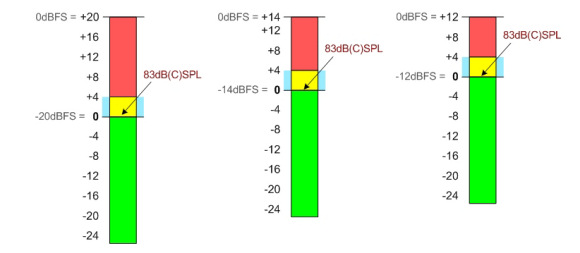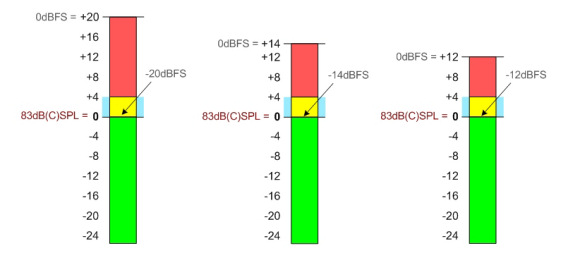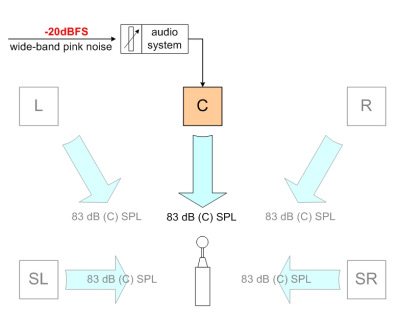
Bob Katz (well known audio professional, mastering engineer and author) proposed a new approach for loudspeaker setup, metering and monitoring in listening rooms based on a fixed relationship of the sound system's digital fullscale signal and the listening level. The basic idea is to standardize the monitoring level in a listening room (any listening room) in relationship to the commonly accepted listening levels and create a fixed ratio between the digital fullscale level of the audio and sound system and the listening sound level.
With todays 20-bit and 24-bit audio systems it is not necessary anymore to 'press' all audio signals into the uppermost 3 or 4dB. The common believe that only highly compressed music sounds powerful and 'loud enough' led to the 'loudness war' we have today. Every music piece should be 'louder' than the competition. Sound quality suffers more and more because of that method. The higher the ratio between RMS level and peak level is the more headroom is needed to keep music 'punchy' and airy. But by keeping a higher ratio between RMS and peak (crest factor) the average level MUST be lower. Otherwise there is no space for the 'invisible' peaks and transient sounds within the music. So 'punchy' music has a lower average level and sounds lower compared to highly compressed music. Played automatically after each other (any playback system), the 'better' sound is perceived 'weaker'! This is the dilemma for all master engineers and producers: going airy and punchy or going loud?
The proposed K-System metering is an attempt to restore a good work environment for mixing engineers and bring needed headroom back into the mixing room. As a result the finished mixes would be not as 'loud' as now, because they wouldn't need to be so highly compressed. To reach this goal comprehension and an 'agreement' between mastering engineers is necessary. See Loudness.
The perceived loudness of a loudspeaker system is generally not connected to the headroom of the system. Id a monitoring system is too low, a mix or other audio processing will be too 'hot' and if the monitoring level is too high the resulting audio signal will be too low. Absolute audio levels will be set automatically and more or less unconsciously depending on the monitoring level of the loudspeaker system. If the monitoring level would be standardized to a certain level below digital fullscale a mixing engineer would automatically set the levels always to the proper range in relationship to fullscale level. Mixing hotter would mean much higher (and may be uncomfortable) monitoring levels, mixing too low would mean too low (and also uncomfortable) monitoring levels. A monitoring system should be set up in a way that the perfect headroom corresponds to the perfect listening level.
This is not new: in the movie production monitoring systems were set up this way for decades! SMPTE RP 200 and SMPTE 202M are the standards that define control room monitors for movie production. As a result the problems with over compressed audio files like in music production are not existent in the movie business! Films are precisely leveled according to the standards and can be played in any cinema worldwide without problems. The goal today is to bring the music production scene to the same agreements to 'end the loudness war'.
A monitoring system that is based on a standardized listening level also assures that individual music pieces with different crest factor (ratio between RMS and peak) will be evaluated by human perception and not only by the meters.
By feeding a certain test level (wide-band pink noise) into the monitoring system, a certain monitoring sound pressure level can be defined. Setting up a system this way the relationship between the system's internal digital fullscale level and the created sound pressure level is fixed.

The system is fed with wide-band pink noise of -20dBFS, -14dBFS or -12dBFS (depending on the favored scale K-20, K-14, K-12). Every loudspeaker channel is adjusted individually to output 83dB SPL(C) 'slow'.
SMPTE (Society of Motion Pictures and Television) defined the reference listening level for film mixing as 85dB SPL(C) 'slow'. This acoustical output should be measured with an input test signal of -20dBFS (RMS) full-bandwidth pink noise. SMPTE RP200 defines as the electrical reference level a level of -18dBFS (RMS). (This difference is not interpreted clearly in the literature.) Here the reference level of -20dBFS is used.
Because of the large necessary level and headroom differences in film work for movie theatres, work for home theatre, broadcast and music three different scales are proposed:
These three scales are different in their relationship to digital fullscale (0dBFS) and therefore in their implemented headroom: 0dB SPL(C) at either -20dBFS, -14dBFS, or -12dBFS (below fullscale).
The K-20 meter is intended for wide dynamic range material, theatre mixes, classical music etc. The K-14 meter is intended for all productions made for home listening and the K-12 meter is intended for broadcast work.
The digital fullscale is always at the top of the K-System meter with the comparable listening level range some dB different on each scale. The "0dB" point on the scales is always the reference point for level comparisons and listening.
 |
| K-20, K-14, K-12 compared to 0dBFS |
 |
| K-20, K-14, K-12 compared to listening reference |
The K-System "K-20" is actually the equivalent for any cinema sound system (SMPTE RP 200-2002 and SMPTE 202M-1998). It permits a maximum listening level of 103dB SPL before clipping: 83dB plus 20dB headroom = 103dB. This is appropriate for a movie theatre and for the control/mixing room. The K-Systems "K-14" and "K-12" are intended for mixing room environments not for large show rooms, music halls or concerts. Because of the smaller headroom between the 83dB SPL reference listening level and 0dB fullscale, the maximum listening level in the control/mixing room is not as high as with a cinema system. The K-14 allows a maximum listening level of 97dB SPL (83dB + 14dB) and the K-12 allows for a maximum listening level of 95dB (83dB + 12dB). (For louder listening the 'general listening level control' can be adjusted by changing the reference level in a controlled way.)
Proposed is a dual-characteristic meter with a bar representing the average level and a moving line or dot above the bar representing the most recent highest instantaneous (1 sample) peak level. The peak and average scales are calibrated as per AES-17 (+20 dB RMS sine wave read the same as +20 dB peak).
As a first step one of the three meter types depending on the kind of work to do must be chosen. The system should be fed with wide-band pink noise after the system is equalized and all levels in the individual units are set. The test signal should be set to -20dBFS, -14dBFS or -12dBFS depending on the favored scale (K-20, K-14, K-12). Every loudspeaker channel is tested individually with all other channels muted. The listening level (SPL) is measured as C-weighted 'slow'. Now each loudspeaker channel is set to generate 83dB SPL(C) 'slow'. The measurement microphone should be placed in the main listening area.
 |
| setup, here K-20 |
Using an 1/3 RTA measurement system, each band (1/3 octave) should read 68dB SPL by feeding -20dBFS into the system. If all the bands are then summarized it will result again in an SPL of 83dB.
The above described difference between -20dBFS and -18dBFS should be settled in this way (Bob Katz): The reference level of SMPTE RP200 as -18dBFS (RMS) is used to generate a sound pressure level of 85dB SPL(C) and the reference level -20dBFS should be used to generate a sound pressure level of 83dB SPL(C).
 |
| -20dBFS, -18dBFS |
With the K-System an additional general listening level control is proposed. This control changes the listening level by increasing/decreasing the level without changing the system setup. This could be necessary because the level of 83dB(SPL) is uncomforting loud depending on the room and environment. The control should have a clear dB marking to keep control of the listening environment.